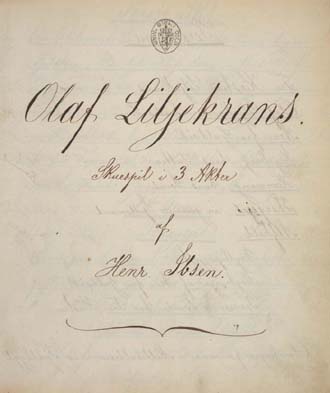
Brief description
The creative process leading to Olaf Liljekrans began with The Grouse of Justedal, a National Play in Four Acts by Brynjolf Bjarme, a drama Ibsen began to write in Christiania in 1850, but never finished. The fragment ends in the middle of the second act.
Six years later, in 1856, he resumed work on the subject. After the success of The Feast at Solhoug, it was tempting for Ibsen to write another play in the style of the folk ballads. The Grouse of Justedal had been inspired by a story in Andreas Faye`s collection Norwegian Legends about a little girl on the farm «Birkehaug» in Justedalen. She was the only survivor in the valley of the Black Death, and when, after a long time, people came from the neighbouring parish and found her, she had become «as timid and wild as a bird» in her solitude, and so was called «The Grouse of Justedalen».
Ibsen included this motif in Olaf Liljekrans, but not a single line from The Grouse of Justedal is to be found in Olaf Liljekrans. Ibsen borrowed the name of the character in the title from a ballad in Landstad's Norwegian Folk Ballads about a man called Olaf Liljukrans who was killed by elves on the eve of his wedding.
Olaf Liljekrans was ready to be handed in at Det norske Theater in Bergen at the beginning of October 1856, and was immediately accepted for staging.
Olaf Liljekrans was first performed at Det norske Theater in Bergen on 2 January 1857. Ibsen directed the production himself. After the success of The Feast at Solhoug the previous year, there were great expectations and there was a full house, but the play was not a success, with either the audience or the critics, and the play was only performed twice.
Ibsen sketched the costumes himself for all the characters in Olaf Liljekrans. The sketches are water-colours and probably formed the basis for the new costumes ordered for the staging of the play.
It was to be almost a whole generation before the play was published for the first time. It was included in Volume 2 of Henrik Ibsens Sämtliche Werke in deutscher Sprache, published in Berlin in 1898. Emma Klingenfeld was the translator. The play was not published in the original language until 1902, in supplementary volume (Volume 10) of Ibsens Samlede Værker (Ibsen's Collected Works).
(From ibsen.net)
Read Olaf Liljekrans (in Norwegian)
In the online version of the official Ibsen edition (HISe), you can read Olaf Liljekrans in various formats. This content is currently only available in Norwegian. Follow the links below to read the play:
Introduction to the work (in Norwegian)
The online version of the official Ibsen edition (HISe) offers extensive information about Olaf Liljekrans in Norwegian. Follow the links below to read about various aspects connected to the play.
About the modified version (1902)
Olaf Liljekrans was first published in the People's Edition, «Folkeutgaven», (1902) and for this purpose Ibsen modernised the language. The first performance of the play took place in 1857.
Read the modified version (in Norwegian)
In the online version of the official Ibsen edition (HISe), you can read Olaf Liljekrans (1902) in various formats. This content is currently only available in Norwegian. Follow the links below to read the play:
Introduction to the modified version (in Norwegian)
The online version of the official Ibsen edition (HISe) offers extensive information about Olaf Liljekrans (1902) in Norwegian. Follow the links below to read about various aspects connected to the play.
- Background
- Creative process
- About the publication
- Translations from Ibsen's life time
- More information
The opera draft [1877/78] (in Norwegian)
Ibsen wrote a draft for an opera based on Olaf Liljekrans. In the online version of the official Ibsen edition (HISe), you can read the draft in various formats. This content is currently only available in Norwegian. Follow the links below to read the draft:
Introduction to the opera draft (in Norwegian)
The online version of the official Ibsen edition (HISe) offers extensive information about the opera draft in Norwegian. Follow the links below to read about various aspects connected to the play.
Reviews
Here you can find reviews in full text and an overview of registered reviews in various languages.
- Reviews from Ibsen's life time in full text
- Reviews registered in the Ibsen bibliography (nb.no)
- Reviews registered in «Norsk litteraturkritikk» (UiO)